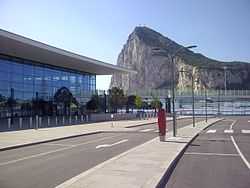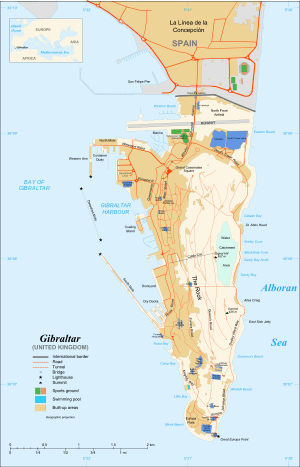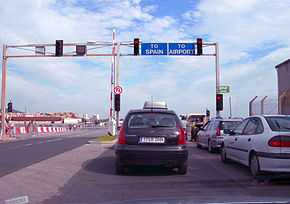Gibraltar International Airport
| Gibraltar International Airport North Front Airport | |||||||||||
|---|---|---|---|---|---|---|---|---|---|---|---|
 | |||||||||||
 | |||||||||||
 GIB | |||||||||||
| Summary | |||||||||||
| Airport type | Military/Public | ||||||||||
| Owner | Ministry of Defence | ||||||||||
| Operator | Government of Gibraltar | ||||||||||
| Serves | Gibraltar | ||||||||||
| Elevation AMSL | 15 ft / 5 m | ||||||||||
| Coordinates | 36°09′04″N 005°20′59″W / 36.15111°N 5.34972°WCoordinates: 36°09′04″N 005°20′59″W / 36.15111°N 5.34972°W | ||||||||||
| Website | gibraltarairport.gi | ||||||||||
| Runways | |||||||||||
| |||||||||||
| Statistics (2012) | |||||||||||
| |||||||||||
Gibraltar International Airport or North Front Airport (IATA: GIB, ICAO: LXGB) is the civilian airport that serves the British overseas territory of Gibraltar. The runway is owned by the Ministry of Defence for use by the Royal Air Force as RAF Gibraltar. Civilian operators use the civilian-operated terminal. National Air Traffic Services hold the contract for provision of air navigation services at the airport.
In 2013 the airport handled 383,876 passengers and 351,867 kg of cargo on 3,564 total flights.[1] Winston Churchill Avenue (the main road heading towards the land border with Spain) intersects the airport runway, and consequently has to be closed every time a plane lands or departs. The History Channel programme Most Extreme Airports ranked the airport the fifth most extreme airport in the world.[2]
Monarch is the largest operator at Gibraltar International, operating three weekly flights to London Luton, Manchester Airport and Birmingham.[3] Both routes are operated by an Airbus A320-200. EasyJet operates seven weekly flights to London Gatwick operated by Airbus A320 family aircraft. British Airways also operates nine weekly flights to London Heathrow being operated by an Airbus A320-200.
Although located in Gibraltar, the airport is also used by people travelling to or from neighbouring parts of the southern Spain such as the Costa del Sol or the Campo de Gibraltar.
History

.png)

The airport was constructed during World War II upon the territory's race course (introduced by the Maltese), when Gibraltar was an important naval base for the British. Originally opened in 1939, it was only an emergency airfield for the Royal Navy's Fleet Air Arm. However, the runway was later extended by reclaiming some land from the Bay of Gibraltar using rock blasted from the Rock of Gibraltar while carrying out works on military tunnels. This last major extension of the runway allowed larger aircraft to land at Gibraltar.
Spain's continuing sovereignty dispute with the United Kingdom over the territory where the airport stands (different from the generic one on Gibraltar itself) has seriously affected the airport's operations. On 2 December 1987, an agreement was signed between the governments of the United Kingdom and Spain to allow the joint civil use of the airport.[4] The agreement foresaw the building of a new terminal in the neighbouring Spanish municipality of La Línea de la Concepción adjacent to the northern side of the existing frontier. However, the agreement was blocked by the Government of Gibraltar, led from 1988 by Joe Bossano. As a result, the agreement was never implemented.
Since then, Spain successfully excluded Gibraltar from European wide de-regulation initiatives, preventing direct links from Gibraltar to the rest of the European Union (except the United Kingdom), on the grounds that no regulation that somehow recognises the sovereignty of the United Kingdom over the Gibraltar peninsula may be implemented without a previous agreement on the airport.
On 3 November 2003, Monarch announced a new route from Gibraltar to Manchester Airport.[5] It was the first route from Gibraltar to operate to the North of England. However on 19 July 2006, Monarch withdrew the route due to the cost. On 21 April 2008, Monarch announced it would resume the services to Manchester from 12 September 2008. The route operates three to five times a week: every Monday, Wednesday and Friday in winter season, as well as on Thursdays and Sundays in the summer season.
By late 2005 and early 2006, the implementation of a new agreement was one of the main topics of the Gibraltar Trilateral Forum being held between the Governments of Gibraltar, Spain and the United Kingdom. As a result, the Córdoba Accord was signed on 18 September 2006 by all parties. This ended all discriminatory restrictions on civilian flights to Gibraltar International, including the prohibition of flights over Spanish soil, and exclusion of Gibraltar from all EU agreements on air transport, allowing civilian flights from all nations into Gibraltar International.[6]
On 17 November 2006 Iberia announced that it would start flights from Madrid to Gibraltar using an Airbus A319 aircraft. This was a landmark move as no Spanish airline had flown to Gibraltar since 1979, because of its disputed status. Iberia began flights to Gibraltar International on 16 December 2006 with a flight from Madrid that included some members of the Spanish Government on board. GB Airways flew a one-off flight in the other direction with a group of children from the Gibraltar area making up the passengers. In May 2007 GB Airways (flying as a British Airways franchisee) also began operating the route between Madrid and Gibraltar, however, this was discontinued on 30 September, leaving Iberia to work the route alone. On 22 September 2008 Iberia announced that it would cease its flights to Madrid by 28 September due to "economic reasons", namely, lack of demand. This left Gibraltar, once again, without any air links with Spain.[7]
In April 2009 Ándalus Líneas Aéreas restored Gibraltar's air link with the Spanish capital.[8] In July 2009 Ándalus also began scheduled flights to Barcelona, increasing the destinations in Spain to two.[9] However, the airline ceased to serve this route in September 2009 due to a lack of demand.[10] In April 2010 it was confirmed that Ándalus flights to and from Gibraltar had been indefinitely suspended.[11] And now yet again, Gibraltar has no direct air links to Spain. Ándalus Líneas Aéreas ceased operations on 13 August 2010.
From 2011 until October 2012, EasyJet offered thrice-weekly service from Gibraltar to Liverpool, but it was eventually cancelled due to lack of demand.
On 18 May 2011, Bmibaby announced that it would launch flights from Gibraltar to East Midlands from 31 March 2012. This was the first time that an airline has operated that route. The route operated on Tuesdays, Thursdays and Saturdays, using a Boeing 737-300. However on 3 May 2012 it was announced that Bmibaby was to be closed down by the International Airlines Group after the group failed to find a buyer for the airline. Bmibaby operated its last service to Gibraltar on 8 September 2012 and the airline operated its last flight on 9 September 2012.
On 10 January 2012, Gibraltar was selected as one of the 'World's Scariest Airport Landings and Take-offs' in the travel section of the Daily Telegraph due to its runway which extends into the sea.[12]
On 14 August 2012, Monarch announced it would launch a new route to Birmingham, operating three times a week; every Tuesday, Thursday and Saturday. The route began on 23 March 2013 but now runs on Tuesdays, Thursdays and Sundays.[13]
In the summer of 2014 services between Gibraltar and Marrakech were operated by Royal Air Maroc Express on behalf of a local company Your Flight.[14] However the services, which were operated on a charter basis, and could not be booked via global distribution system channels or on a connection basis, terminated after just three months due to insufficient demand.[15]
It was announced in November 2014 that the short intercontinental air connection between Gibraltar and Tangier would be restored after many years and operated by Royal Air Maroc with services beginning in March 2015 on a twice weekly basis. Unlike the previous Marakech flights these would be operated by RAM for themselves, and offer connecting flights to their Casablanca hub and onwards, and be available via normal sales channels.[16]

Terminals

There is one terminal at Gibraltar International. Flight departures moved into the new terminal on 26 September 2012 when the old terminal was closed on 25 September 2012.[17]
Old terminal
The old terminal at the airport was built in 1959 and refurbished in the late 1990s.[18] For many years, it had been too small to cope with the number of passengers. The size of the terminal was 20,000 m2 (220,000 sq ft), and had 10 check-in desks, one baggage carousel, one security gate and two departure gates. The departure gates then enabled passengers to board a bus which takes them to one of the new stands. On 26 November 2011, arriving flights switched to the new terminal as the first phase of the new terminal opened. On 25 September 2012, the old terminal closed its doors as flight departures moved into the new terminal on 26 September 2012. The last flight to use it was EasyJet flight EZY8904 to London-Gatwick. The old terminal building was demolished in February 2014 and will make way for a new coach park.
New terminal
A new terminal has been constructed at Gibraltar International[19] due to the high number of passengers using it. Planning permission was announced in 2007 with construction of the new terminal began in 2009 and was finished by 2011. The first phase of the new terminal opened on 26 November 2011 for arriving flights only. The second phase of the new terminal opened on 26 September 2012 when flight departures moved. The first flight to use the first phase was EasyJet flight EZY7295 from Liverpool and the first flight to use the second phase was British Airways flight BA491 to London Heathrow. The terminal's terrace was inaugurated by the Earl of Wessex, Prince Edward on 13 June 2012.[20]
The terminal is 35,000 m2 (380,000 sq ft), which is 15,000 m2 (160,000 sq ft) bigger than the old terminal. It has two baggage carousels and three departure gates, none of which are equipped with jet bridges. Only one of the two baggage carousels is in use for flights. It has a passenger capacity of up to 1.5 million passengers per year. Retail services are also available in the terminal and these include WH Smith, 36 North Bar and Gibraltar Duty Free Stores. A new general aviation area has also been built inside the terminal to handle private aircraft.
New road access

The road across the runway is constraining operations at the airport, especially with the increase in operations since the Córdoba Agreement. Prior to this agreement, only three flights operated daily to Gatwick and Luton, and three flights a week to Manchester. On busy days, at present, some seven flights now arrive and depart. If the average time the road is closed for an aircraft to land or depart is ten minutes, then on certain days the road can be closed for over two hours.
Because of this, a new four-lane diversion road and tunnel section was planned. The new runway tunnel will reduce delays and tailbacks caused by aircraft taking off and landing.[21] Construction of the new road was due to begin in January 2008 and be completed by the beginning of 2009,[3] however it is still not completed. The road across the runway will remain in place, for exceptional, specific or emergency use. But it will not be available for routine day-to-day, only for private vehicular traffic. Pedestrians will not be required to travel via the new road/tunnel, and will continue to cross the runway at the present location.
A new dual carriageway is also being built. It will pass under the new terminal and towards the eastern edge of the runway at which point it will pass through a tunnel under it and connect via a roundabout with Devils Tower Road on the opposite side of the runway. After the road tunnel on the north side of the runway the new road will run parallel to the frontier, passing under the air terminal fly-over section. The road will then branch into two, with one road leading to the loop and the frontier, and another leading to the Air Terminal, North Front and Winston Churchill Avenue.[3]
New car parks
There will be several car parks built at Gibraltar International during its expansion. A new 220-space, three-storey car park located at the east of the new terminal. Another new car park will be built by Eastern Beach, and two multi-storey facilities will also be built on Devil's Tower Road.[3] The old terminal building will also be demolished to make way for a coach park.
Airlines and destinations
| Airlines | Destinations |
|---|---|
| British Airways | London-Heathrow |
| easyJet | Bristol, London-Gatwick |
| Monarch Airlines | Birmingham, London-Luton, Manchester |
| Royal Air Maroc Express | Casablanca, Tangier |
Statistics
| Passengers | Aircraft movements | Cargo (tonnes) | |
|---|---|---|---|
| 2008 | 378,603 | 3,958 | 624 |
| 2009 | 371,231 | 4,290 | 313 |
| 2010 | 305,325 | 3,346 | 296 |
| 2011 | 383,013 | 3,628 | 292 |
| 2012 | 387,219 | 3,490 | 314 |
| 2013 | 383,876 | 3,564 | 352 |
| 2014 | 415,103 | 3,730 | 384 |
| Source: Gibraltar Airport Statistics[22] | |||
Accidents and incidents
- On 4 July 1943, a B-24 Liberator II crashed into the sea 16 seconds after taking off from Gibraltar Airport at 23:07 hours, killing all 11 passengers and five of the six crew. Among the passengers was Lt. Gen. Władysław Sikorski, commander-in-chief of the Polish Army and Prime Minister of the Polish government in exile, who had been inspecting Polish forces in the Middle East during World War II. A British inquiry ruled the crash an accident, concluding that the plane's controls had jammed for an unknown reason. However, several conspiracy theories continue to persist.
- On 22 May 2002, a Monarch Boeing 757-200 (Registration G-MONC) suffered structural damage to the forward fuselage in the area of the nose landing gear during landing at Gibraltar while operating a flight from Luton. The captain had used an incorrect landing technique, applying full nose-down elevator. This control input resulted in a high pitch-down rate at nose-wheel touchdown, exceeding the design limits, before the aircraft's nose-wheel had touched the ground. There were no injuries.[23]
- On 17 March 2006, the flight deck crew of a Monarch Boeing 757-200 (Registration G-MONE) lost visual contact with the runway after passing the Visual Decision Point (VDP) while attempting to land at Gibraltar. During the subsequent go-around, the crew did not follow the correct missed approach procedures but air traffic control (ATC) provided effective heading control to avoid striking high ground. The lowest altitude of the aircraft when over land was 2,100 ft (640 m). (The highest local ground elevation, just south of the airfield, is 1,420 ft (430 m)). Following the incident, ATC and Monarch changed their procedures to reduce the chances of repeating a similar occurrence.[24]
In popular culture
The airport appeared on Channel 5's series, Gibraltar: Britain in the Sun which was broadcast from June to July 2013.
References
- ↑ "Gibraltar International Airport Traffic Statistics 2013" (PDF). Gibraltar International Airport. Retrieved 5 December 2014.
- ↑ Most Extreme Airports; The History Channel; 26 August 2010.
- ↑ 3.0 3.1 3.2 3.3 Birmingham Airport. "Monarch Celebrate First Flight to Gibraltar from Birmingham Airport". Retrieved 25 March 2013.
- ↑ "Joint Civil Use of the Airport". Retrieved 15 August 2004.
- ↑ "2008 News Archive – Flights – Monarch Scheduled launches three new routes from Manchester to Barcelona, Gibraltar and Tenerife | Flights News". Monarch.co.uk.
- ↑ "Córdoba Tripartite Agreement". Retrieved 22 November 2006.
- ↑ "Spanish Airline Suspends Flights". Sky News. 22 September 2008. Retrieved 22 September 2008.
- ↑ "Ándalus airlines restores link with Madrid". Gibraltar Chronicle.
- ↑ "Ándalus signals Barcelona start". Gibraltar Chronicle.
- ↑ "Ándalus pulls Barcelona route". Gibraltar Chronicle.
- ↑ "Breaking news: Air Andalus Abandons Gib Flights – Report". Gibraltar Chronicle.
- ↑ "The Telegraph – World's Scariest Airport Landings and Take-offs". The Daily Telegraph (London). 10 January 2012. Retrieved 10 January 2012.
- ↑ "Monarch Launch New Birmingham To Gibraltar Route". Monarch.co.uk. 23 March 2013.
- ↑ "GBC – 'Your Flight' to begin Marrakech link in April". Retrieved 14 January 2014.
- ↑ "GBC – 'Flights to Marrakech discontinued by Your Flight". Retrieved 12 November 2014.
- ↑ "Royal Air Maroc press releass - 'Signature d'une convention de partenariat entre RAM et Gibraltar - Royal Air Maroc lance la ligne Tanger Gibraltar". Retrieved 12 November 2014.
- ↑ "Gibraltar Chronicle – The Independent Daily First Published 1801". Gibraltar Chronicle.
- ↑ "Gibraltar Old Terminal". Gibraltar Chronicle. 26 September 2012.
- ↑ "Gibraltar Airport - Visitors Guide". Retrieved 20 November 2013.
- ↑ "Integration of new terminal". Gibraltar Chronicle.
- ↑ Gibraltar Road
- ↑ "Gibraltar Airport Statistics". Gibraltarairport.gi.
- ↑ Air Accidents Investigation Branch (22 May 2002). "Monarch Accident G-MONC". Aaib.dft.gov.uk.
- ↑ Air Accidents Investigation Branch (17 March 2006). "Monarch Accident G-MONE". Aaib.dft.gov.uk.
External links
![]() Media related to Gibraltar Airport at Wikimedia Commons
Media related to Gibraltar Airport at Wikimedia Commons
- Official website
- Press Release for New Air Terminal, tunnel under the runway and new road leading to all parts of Gibraltar north of the runway
- Artist's rendition and architectural designs for new Terminal
- Airport information for LXGB at World Aero Data. Data current as of October 2006.
- Unofficial Website with information on the Gibraltar International Airport
| ||||||||||||||||||||||||||||||||||||||||||||||||||||||||||||||||||||||||||||||||||||||||||||||||||||||||||||||||||||||||
| ||||||||||||||||||||||||||||||||||||||||||||||||||||||||||||